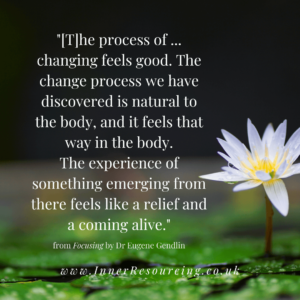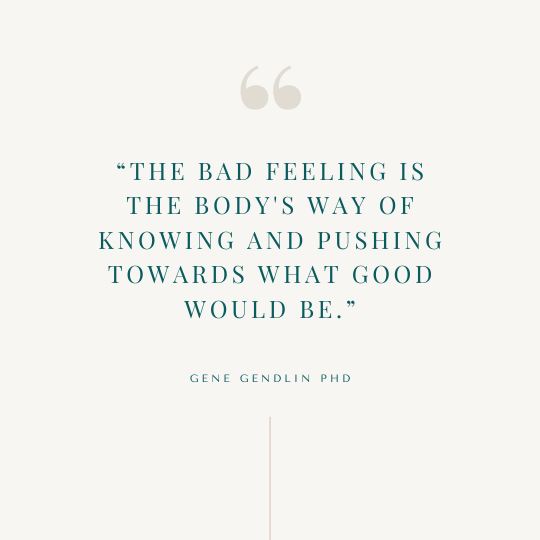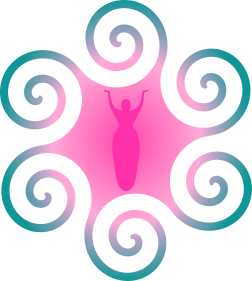Experiential Focusing, (or just “Focusing”) is a transformative process of inner enquiry, self-understanding, and change.
This makes it helpful for anyone who wants to be more true to themselves, and to be fulfilled at work and in life.
Focusing is a mind-body process that involves getting in touch with something called the “felt sense” (described in detail below) so it’s sometimes called “felt-sensing”.
It was developed in the 1960s by Dr Eugene Gendlin, who is known for his extensive work in the fields of both philosophy and psychotherapy.
This guide gives you an overview of some key points about Focusing/Felt-sensing. Plus links to further information and learning resources.
In this guide:

Why learn Focusing?
Focusing guides you to a deep level of compassionate awareness and relationship with yourself.
It can allow you to quickly get to the root of what’s troubling you, driving you, inspiring you, or blocking you. That’s because it provides a bridge between felt, but not yet verbalised, feelings, ideas, and experience, and your cognitive, thinking self.
It’s essentially a compassionate, moment-to-moment conversation between your wise body, smart brain, and loving heart.
Through Focusing you can clarify your hopes and dreams and better understand concerns and areas of difficulty.
Focusing can help you to deal with difficult, negative, or confusing feelings.
It gives you a structured process for relating to your concerns from a place of empowered presence.
This allows you to identify and change how your problems or blocks are concretely held in your body. It’s at this deep level of bodymind where unresolved blocks/problems exist.
Focusing also enables access to vast resources of inner wisdom about life situations and relationships. It liberates your creativity and problem solving abilities.
If you’ve checked out the other pages on this site, or follow me on LinkedIn, you may have noticed I often mention connecting to your inner compass and accessing your inner resources. Focusing/felt-sensing is the essential technique I use myself, and teach others, for this.
Interested in learning Focusing? Check out my new course here…

What is Focusing/Felt-sensing used for?
Focusing has a solid evidence base, and is grounded in a mature body of practice, theory, research, and philosophy. It is used worldwide in all kinds of settings, and in relation to many topics, including:
- Focusing-oriented psychotherapy
- creative writing and thinking, and theory building (especially as “Thinking At the Edge”)
- spiritual inquiry
- self-care
- becoming more authentic
- self-awareness and growth
- mindfulness practice and teaching
- Focusing-oriented coaching (which is the kind of coaching you’ll get here)
- teaching
- conflict resolution
- community building
- …and much more…
Focusing relies on the “Felt Sense”.
So you’re probably wondering… what exactly is that?
The Felt Sense
What is felt sense?
A felt sense is the bodily-held sense of the whole of a situation, relationship or issue
The felt sense is Gendlin’s term for a holistic sense, experienced via the body, which encompasses and describes the wholeness or “more” of an issue, or of how you are in general. It’s more than thoughts, emotions, sensations, or ideas. It encompasses all of these in a single coherent experience.
Because it is holistic and includes the whole system and all its interconnections, getting in touch with your felt sense of an issue is the key to positive change.
Dr Gendlin discovered that when someone pays attention to this “felt sense” of something, and stays with that experience, allowing it to be there fully, it changes, and the way the person is holding the issue or problem changes too.
“What is split off, not felt, remains the same. When it is felt, it changes. Most people don’t know this! They think that by not permitting the feeling of their negative ways they make themselves good. On the contrary, that keeps these negatives static, the same from year to year.
Dr Eugene Gendlin
A few moments of feeling it in your body allows it to change. If there is in you something bad or sick or unsound, let it inwardly be and breathe. That’s the only way it can evolve and change into the form it needs.”
Focusing is a way of listening deeply to this experiential sense of who we are and how we are.
I think of it as a portal into your aliveness.
In essence, Focusing/Felt-sensing is a proven, step-by-step method for bringing this special kind of attention to whatever is being held in your body, so that it can change, and resolve. Then something fresh – some new energy, direction or creativity – can emerge.
To get more of a feeling for what a felt sense is, you might like to try this brief exercise:
A Felt Sense Exercise for Beginners
Try this brief exercise in felt-sensing (read through the steps first so you have a sense of what’s coming next):
Take your time.
Felt Sense Exercise Part 1
- Sit somewhere quietly, and see if you can set aside day to day worries and concerns for a few moments. Pause for a while (try a slow count up to 10) noticing that you are present here and now. (It can help to notice the contact between your body and the chair and/or floor. Notice your breathing for a few breaths, not trying to change it, just noticing how it is.)
- If it feels ok to do so, close your eyes. Bring to mind someone you know and love – a friend, family member, even a pet. Imagine that person is with you now, in the room with you.
- Notice – what is that like? You may become aware of thoughts, memories, emotions, and/or sensations like a warm glow, or an expansive feeling in your heart, or something else. (Usually, a felt sense is strongest in the middle of the body – the throat, chest, stomach, and belly.)
- Don’t try to grasp at any aspect in particular, or make anything in particular happen. Just notice what you notice as you invite a sense of “all about this person”. Take your time.
You’ll probably notice you can get a holistic sense of this person, and your relationship with them, that somehow captures “more than” the details of it. This is a “felt sense”.
NB what you notice might be strong and obvious, or it might be very subtle.
Felt Sense Exercise Part 2
- Now open your eyes and give yourself a shake to reset your body. Then repeat step 1 from Part 1.
- This time you’re going to bring to mind someone that you don’t get on with, or find awkward or difficult to deal with. Again imagine that this person is with you now, in the room with you.
- Notice – what is that like? You may become aware of thoughts, memories, emotions, and/or sensations like a tightness, or an closed down feeling in your stomach, or something else.
- Again, don’t try to grasp at any aspect in particular, or make anything in particular happen. Just notice what you notice as you invite a sense of “all about this person”. Take your time.
Notice the holistic sense of this person, and your relationship with them, that somehow captures “more than” the details of it. Notice how this “felt sense” is different from the felt sense of the person in Part 1.
Felt Sense Exercise Part 3
If it feels ok, you might try going back and forth from the person in part 1 to the person in part 2 a few times. Notice how your body has a clear and definite sense of each person and how they are different.
Take a moment to thank your body for showing you what it knows about these two people.
Download a print-friendly pdf of this Felt Sense Exercise here…
There’s a further Focusing process called “Clearing a Space” described in this article, entitled “Embodied Ways to Help Your Stressed Brain to Focus”. This uses the felt sense. There’s also a guided audio for the Clearing a Space process at the end of the article.
More about the felt sense
Perhaps you were able to tell from the above felt-sensing exercise how the felt sense includes many aspects including:
- thoughts (e.g. he is so annoying)
- gut feelings (e.g. I have a hunch she’s jealous of me)
- emotions (e.g. I feel happy when I’m with them)
- memories (e.g. that time they…)
- sensations (e.g. my shoulders relax when I imagine being with them)
- even movement and gestures (e.g. I really want to push them away from me)
The felt sense of something is more intricate, more precise, richer, more profound, and more holistic than just how you feel about it, or what you think about it, or even the story you’re used to telling yourself about it.
Because of this it often shows up as a metaphor:
“it’s like I’m falling down a well”
“I’m stuck in no-man’s-land, and I’m not sure if they’re going to start shooting again”
“it feels as if I’m walking through treacle”
“it’s as if there’s an excited little squirrel jumping about in my tummy”
In Focusing, and in Conscious Career Coaching we work extensively with metaphors like this.
Or have a look at what small group workshops I have upcoming here…
What the Felt Sense isn’t
You may sometimes come across non-Focusers using the term “felt sense” to mean simply “something felt in the body”. For example, a physical sensation like warmth, or tightness, or the stomach dropping. This seems to be more and more common in the embodiment community who may have come across the term without really understanding what is meant by it.
Although the felt sense is in the body, it isn’t just a sensation like pain or hunger, or relaxation, though these may be part of it.
I believe this looser use of the term is based on a misunderstanding of what the felt sense actually is, and what Focusers mean when they talk about “the body”…

What is meant by “body” in Focusing?
When we talk about “the body” in Focusing we don’t just mean what you’d think of as your physical body.
We mean the whole of your present experiencing as felt through your body and senses. The body in its situation.
The felt-sense is essentially a brain-and-its-connections-in-and-through-the-body phenomenon.
It can sometimes include things that we perceive as being outside our physical boundaries. This might sound a bit odd, but this concept is quite common in our metaphorical language e.g.: “She was beside herself”, “I hit the roof.”

Where does Focusing come from?
In the 1950s and 60s, Dr Eugene Gendlin was part of a research team at the University of Chicago working with Dr Carl Rogers (founder of the Person-Centred Approach). They were researching why some clients did better than others in psychotherapy.
Thousands of client-therapist recordings were analysed. Initially, they were looking at what the therapists were doing.
Unexpectedly, the data showed that different therapist techniques and approaches made little difference to outcomes.
Instead it was something the clients were doing inside themselves.
The felt sense makes an appearance
Clients who spent more time in a state of present-oriented openness/curiosity towards “what am I feeling about this now?” did better than clients who tended to just talk about their experiences. Those who paused to sense into their feelings did better than those who described their feelings.
Most shockingly, researchers discovered they could predict within the first couple of sessions who would have successful outcomes from therapy and who would not.
(This research led to the “Experiencing Scale” which is widely used in psychology and psychotherapy.)
Gendlin coined the term “felt sense” to describe the holistic, fuzzy, sense of “all about this issue/situation/symptom/relationship/etc” that these clients were tapping into.
Gendlin set out to discover whether felt-sensing could be taught.
And he found that – yes it can! People who naturally approach things in this way can get better at it. Those who don’t can learn.
Focusing as a structured and teachable process was born.
Why “Focusing”?
The felt sense is an experience that many of us have naturally.
Gene called the process of finding it and working with it “Focusing” because you focus your attention in a particular way. It doesn’t mean “focusing” as in concentrating on a narrow set of things. In fact almost the opposite, as your field of perception widens and deepens during Focusing.
This gives you access to your bodily held wisdom about what ever it is you are focusing with.
Gene’s “Philosophy of the Implicit” underpins the practice of Focusing and its allied practice “Thinking at the Edge”.
More about Dr Gendlin, and the body of work that is Focusing and the Philosophy of the Implicit, is available at the websites of the British Focusing Association, and the International Focusing Institute. (Opens in new tab.)
Why this is important if you’re thinking about working with a coach (or you are one)
While coaching is not therapy, it does share a great deal of common facets.
Both are helping relationships. Both involve talking about your life, your work, how you relate to these and what you think and feel about them.
Positive change is the same outcome sought by both coaching and therapy clients.
So it makes sense that if this way of “inner experiencing” helps people succeed at therapy, it would also help them succeed in coaching.
You see, people often come to coaching to work on issues of doing or having. Yet being underlies all of this.
How you are with yourself, and your manner of experiencing, have been shown to be important factors in successful positive change.
Yet I know of only a handful of coaches who take this into consideration. And even less who teach their clients how to do it.
According to the research (since backed up by further studies) you can make the most of your coaching time and investment by learning Focusing. And/or working with a focusing-oriented coach.
Find out more about how you can learn Focusing or experience Focusing-oriented coaching…

Applying Focusing to Coaching: Inner Resourcing
I often talk about my work as going “beyond mindset”.
Because what you think about things is only a tiny part of what you know about it.
If blocks are in your thinking, in your belief systems, sometimes they can be removed by mindset work.
However, more often blocks are held in the body – and they come from the body.
When you work directly with the body you work directly with the source of the blocks.
And, you directly access the source of your power, your wisdom, and your innate sense of what is the right next step, for you, in this situation.
So I bring this into all of my work with clients. It would be foolish not to!
Check out my introductory Focusing course:
“Be True to You – Finding Your True Self with Felt Sensing”
Inner Relationship Focusing
Inner Relationship Focusing (IRF) is based on Gendlin’s findings and philosophy. It was developed by Ann Weiser Cornell and Barbara McGavin.
This branch of Focusing is the one which has most influenced my work.
If you’ve heard of Internal Family systems, IRF has some similarities in its working with parts/subpersonalities.
A main difference according to Ann Weiser Cornell, is that, in alignment with Gendlin’s work, IRF doesn’t assume that the parts are fixed or static. So we don’t label them as “managers” or “protectors”. They don’t need to be concreted in this way. They are processes that have become stuck and, through working with them, those processes can “unstick”, return to a fluid process state and, reintegrate into a more whole person.
Other applications of Focusing
Focusing can be crossed successfully with a great deal of other helping techniques and approaches. That’s because focusing is about your relationship with yourself – it’s a way of being, a way of relating to yourself and the world.
So once you’ve learned it, you can integrate it with other things you do, like meditation, other kinds of bodywork, dance, business writing, all kinds of creativity, parenting, managing and leading teams.
And more about Focusing and how to get started with it here…